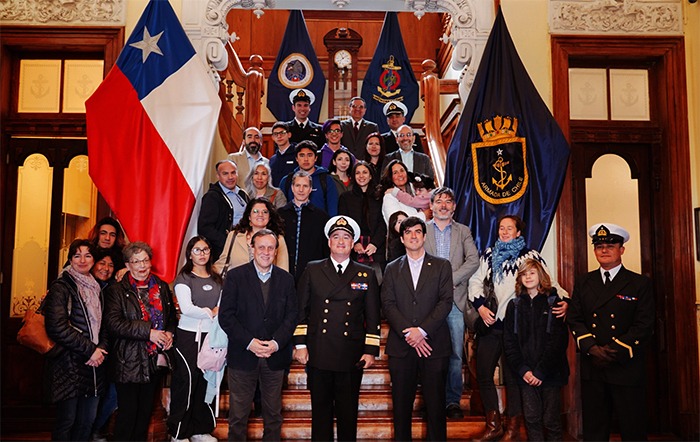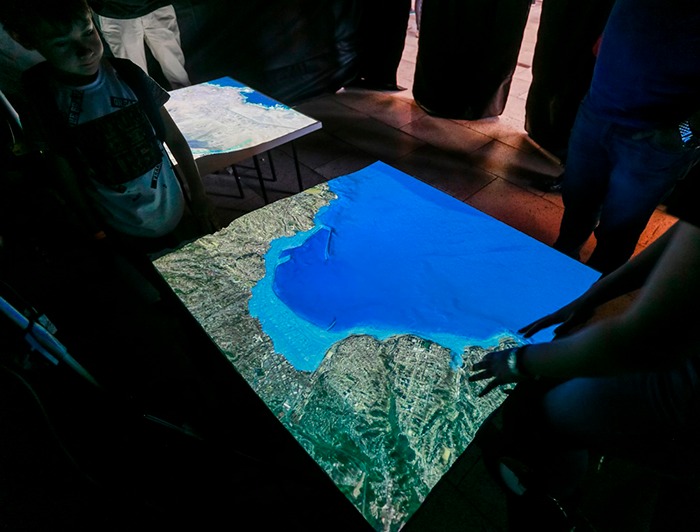This innovation is part of the National Tsunami Warning System (SNAM), which is one of the five most advanced tsunami warning and forecast systems in the world that the Navy Hydrographic and Oceanographic Service (SHOA) has. It was developed by researchers from both universities through the Research Center for Integrated Disaster Risk Management (CIGIDEN), as part of a FONDEF project.
PUC Communications.- The rectors of the Catholic University and the Federico Santa Maria Technical UniversityIgnacio Sánchez and Juan Ignacio Yuz, respectively, visited the facilities of the Navy Hydrographic and Oceanographic Service (SHOA)located in Palacio Espejo in Valparaíso, within the framework of Heritage Day 2023 and in order to learn about the new Integrated Tsunami Prediction and Alarm System (SIPAT): technology created jointly by researchers from both higher education institutions, through the Research Center for Integrated Disaster Risk Management (CIGIDEN); the National Research and Development Agency (ANID); the collaboration of Japanese and German institutions; and thanks to exchange programs and bilateral cooperation of these countries.
“This interdisciplinary work between universities and also together with SHOA, is very revealing to know how to react later in the face of emergencies as well as to be able to visualize this phenomenon in an integrated way, thus promoting cooperation between countries to maintain transnational alert systems,” he commented. Principal Sanchez.
SIPAT is part of the National Tsunami Warning System (SNAM), one of the five most advanced tsunami warning and forecast systems in the world that SHOA has. This innovation is a FONDEF project and “now constitutes a patrimony of all Chilean men and women, a product of the virtuous collaborations that have been fostered between SHOA and the universities that make up CIGIDEN. In addition to the powerful network of national and international cooperation that has been cultivated after 27F”, highlighted the director of this center and academic of the UC College of Engineering, Rodrigo Cienfuegos, who also participated in the tour with the rectors together with the director of the Hydrographic and Oceanographic Service of the Navy, Arturo Oxley; and the dean of UC Engineering, Loreto Valenzuela.

scientific heritage
Cienfuegos pointed out that one of the great learnings of 27F was to bring the State technical institutions -as is the case of SHOA- closer to the research, development and innovation that is carried out in universities. “The FONDAP Centers of Excellence were created for this purpose and CIGIDEN specifically, to improve Disaster Risk Management, connecting research with decision-making.”
The UC researcher stressed that the sum of research, development and innovation has allowed SHOA to provide technical tools to anticipate and zone the danger of tsunamis in the country in just 30 seconds, after having a quick estimate of the seismic source obtained from of national and international institutions. This currently allows an evacuation to be decreed by sectors, “which constitutes an enormous gain, since before having this system in operation (SIPAT), the entire coast of the country had to evacuate over 30 meters in the event of an earthquake equal to or greater at 7.5”.
“This interdisciplinary work between universities and also together with SHOA, is very revealing to know how to react later in the face of emergencies as well as to be able to visualize this phenomenon in an integrated way, thus promoting cooperation between countries to maintain transnational alert systems” – Ignacio Sanchez, rector UC. Share
In this sense, the UC academic stressed that this technological advance requires continuous education and awareness work, such as the one that is done through the models that are part of the dissemination project “Chile, Territory in Motion”, since in some earthquakes people should make the decision to self-evacuate when they perceive that the earthquake lasts more than a minute and it is difficult for them to stay on their feet. “This is because the first tsunami waves can reach the coast in a time comparable to what is required to process the seismic signals and have the technical background to order an evacuation,” he said.
«Our coastline is undoubtedly a cultural heritage that from time to time is affected by the ravages of nature. With the work carried out with CIGIDEN we will be able, for example, to see the reality of tsunamis projected in 3D models that represent the relief of Chilean coastal cities or how it also occurs with the propagation of tsunamis on a global scale, from Japan to Chile”, added the UC Chancellor.

public access
During the 2023 Heritage Day tour, the public that attended the SHOA facilities was able to access the exhibition prepared by CIGIDEN, where two 3D models were shown on which past tsunami scenarios are projected in coastal cities, a simulator of Trans-oceanic tsunamis and a vertical evacuation experience in virtual reality for the city of Viña del Mar. In addition, the Operations Room of the National Tsunami Warning System (SNAM)considered among the five most important and advanced warning centers worldwide, according to the United Nations.
«It now constitutes a patrimony of all Chileans, a product of the virtuous collaborations that have been fostered between SHOA and the universities that make up CIGIDEN. In addition to the powerful network of national and international cooperation that has been cultivated after 27F» – Rodrigo Cienfuegos, director of CIGIDEN on SIPAT. Share
In relation to the two 3D models that are part of this interactive exhibition, they represent the relief of coastal cities where tsunami waves are projected to recreate the floods produced after the Valparaíso earthquake of 1730 and the Maule earthquake of 2010. Thus It is possible to dimension, thanks to a digital projection, how was the entry of successive waves into the Constitución Bay in the early morning of 27F, and represent the potential effects that a tsunami similar to the one that occurred on 8 would have -in the current Valparaíso Bay- July 1730.
“Being able to carry out these types of activities somehow allows us to sensitize people about the importance of being informed and prepared for a possible tsunamigenic event,” said the deputy director of SHOA, Captain Carlos Zúñiga, who also valued the educational work being carried out by CIGIDEN.
“Being able to carry out these types of activities somehow allows us to sensitize people about the importance of being informed and prepared in the face of a possible tsunamigenic event”- Deputy Director of SHOA, Captain of the Frigate Mr. Carlos Zúñiga
Also, attendees were able to observe how tsunamis spread on a global scale (from Japan to Chile, for example), through the TsunamiLab interactive simulator, and visualize how this phenomenon can affect the entire Pacific basin. Hence, the importance of cooperation between countries to maintain transnational warning systems.
virtual evacuation
During a tsunami emergency, horizontal evacuation is considered the most important and effective method to save human lives. However, research shows that in Chile and several other places around the world it is unlikely that some coastal communities will achieve a safe evacuation, before being hit by the tsunami wave.
CIGIDEN also allowed those present to live a vertical virtual evacuation experience, through an immersive virtual reality tour on an urban scale –which uses virtual environments based on more than 400 360º images captured on the ground (like Google Street View)– with the objective of knowing what people do in times of emergency in the face of a near-field tsunami.
“People’s evacuation actions will be automatically captured through virtual reality headsets, which will allow the collection of a large amount of data to evaluate and strengthen the evacuation models currently being developed by the project,” said the CIGIDEN lead researcher and academic. UTFSM, Jorge Leon.
This experience is part of the Fondecyt 1210184 project: “Integrative framework for vertical evacuation planning due to tsunami”, led by Jorge León and an interdisciplinary team from CIGIDEN, which includes academics Patricio Catalán (UTFSM) and Rosita Jünemann (UC), and the researchers Alejandra Gubler (UTFSM) and Javiera Castañeda (UC).
According to CIGIDEN experts, this research and the voluntary participation of people opens the possibility of evaluating structures such as buildings, shopping centers and others, from an architectural and structural point of view, for a possible vertical evacuation, as well as the location of these, and the behavior of the community at the time of evacuation, among other factors.





![[Img #74692]](https://thelatestnews.world/wp-content/uploads/2024/12/What-do-11-and-12-year-old-boys-and-girls-150x150.jpg)



![[Img #74692]](https://thelatestnews.world/wp-content/uploads/2024/12/What-do-11-and-12-year-old-boys-and-girls-300x200.jpg)

